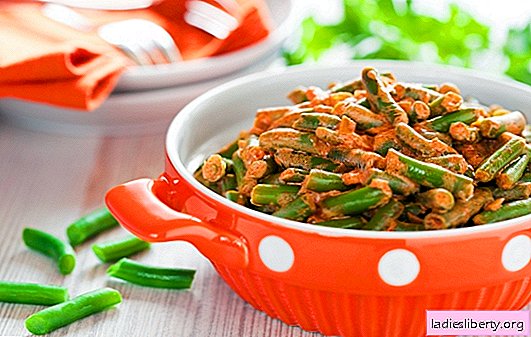
The beauty and diversity of species and varieties of lilies, along with roses, occupy the first place among the garden flowers.
Every year there are all new varieties of lilies, and in this variety is difficult to understand. Before you start growing, you should understand the similarities and differences in species.
Buying lily bulbs, you need to focus not only on beauty, but also on endurance.
Growing lilies. Selection of planting material, varieties
Lilies belonging to the family Lily, are grown from bulbs and are perennial plants, wintering in open ground. Once you have landed an onion, you can admire a beautiful flower for several years, the main thing is to create the necessary conditions and properly care for it. In the cultivation of lilies of different varieties there is much in common, but still care for plants of different groups is slightly different. In order to at least a little understand this question, let us turn to the classification of lilies.
In nature, these flowers grow in warm areas with a suitable climate. The division of lilies into wild (species) and hybrid (varietal) is accepted. Breeders are working on breeding all new varieties, differing not only in the beauty and elegance of flowers, but also winter hardiness and resistance to diseases and pests. Now in the world there are at least 3 thousand varieties. In order to systematize a huge variety of lilies, an international classification was established.
According to this classification, all varieties are grouped into eight sections. These included hybrids according to their origin, considering which varieties the new hybrid was derived from.
So, the main groups of hybrids:
• Asian;
• Oriental;
• American;
• Long-flowered (longiflorum);
• Tubular and Orleans;
• Martagon;
• Candidum;
• New hybrids (OT, LO, OA, LA).
Lilies are also classified in shape and arrangement of flowers. In relation to the stem, flowers can look up, down, to the side. Their shape is tubular, funnel-shaped, in the form of a bowl, bell-shaped, star-shaped, with wrapping petals, etc. The inflorescence contains 8-16 flowers, in some varieties - up to 30 pieces. Flowering lasts a long time, as the flowers open gradually, starting from the bottom of the inflorescence to the top. Coloring of flowers can be the most various, except blue.
The most common hybrids
• Asian. These are unpretentious lilies possessing frost resistance, they winter without shelters. Can grow both in the sun and in light partial shade. They develop poorly on calcareous soils, preferring neutral soils and with weak acidity. Propagated by daughter bulbs, grow several years without a transplant. Some varieties on the stems form a small aerial onions (bulbs). When the lilies bloom, the bulbs fall to the ground and germinate. This is the easiest way to breed. Asiatic lilies bloom at the end of June. The color of flowers is varied, from white to dark burgundy. The flowers consist of six petals and are completely odorless.. The shape of the flower is stalk-shaped or cupped. Although the most popular plants in this group are with flowers looking upward, but lilies with flowers directed towards them create a special mood.
• LA hybrids. The result of crossing long-flowered and Asiatic lilies. The most common group of lilies that have received the best qualities of "parents." From Asians they got winter-hardiness, from Longiflorum - large flowers with a wax-like texture of petals. Flowers of bright colors are directed upwards, many varieties have a delicate aroma. Hibernate in open ground, if there is little snow, light cover with peat or humus is required. LA hybrids multiply easily, forming a large number of babies. They do not form small bulbs. Bloom profusely around the same time as the Asians. Almost do not suffer from fungal diseases, so keep green leaves until autumn.
• Oriental (Oriental). A group of beautiful exotic plants bred as a result of breeding species of lilies growing on the southern coast of Japan. Star-shaped flowers reach a diameter of 25 cm, very fragrant. The color is white, pink, some varieties have a golden stripe running along the center of the petal. The vegetation period is long, therefore a winter shelter is required. In the Orientali garden it is rather difficult to grow. Many growers successfully breed them in greenhouses for cutting. In winter, the bulbs should not be soaked, so in the fall they need to be covered from excessive moisture. Orientali prefer sunny, windless areas and fairly fertile, drained soil of weak acidity. They bloom in July and August.
• OT-hybrids. The result of a successful crossing of Orientals and tubular hybrids. Tall plants with large flowers of lemon, cream, yellow color in combination with red and crimson. Flowers have a pleasant aroma, more subtle in comparison with oriental hybrids. Winter hardiness in OT hybrids is higher than in eastern ones, but still it is necessary to create the necessary conditions for better wintering. The bulbs do not tolerate wetting in the winter, so from the end of September until the very frost a shelter is required to protect it from rain in the form of a plastic film. In dry weather in the fall, the film is periodically removed for ventilation, cleaned in late April.
• LO hybrids. New varieties obtained by crossing the Eastern and Long-flowered hybrids. The shape of the flowers, directed to the side of a strong, well-leafy stem, short-tubular or funnel-shaped. Flowers reach 25 cm in diameter, the color is white, white and pink, the aroma is pleasant and delicate. Do not require special growing conditions, grow on different soils. For wintering requires cover of spruce branches.
Bulb selection
Usually, when purchasing new plants for a site, they are guided by the principle that they should be liked and decorated as a flower garden decoration. We should not forget about the main thing - the ability to create the necessary conditions for growth. Which varieties of lilies are best grown on the site depends on the taste, but If you do not have experience in growing lilies, start with unpretentious Asian hybrids.
One of the best Asian varieties, beautiful and easy to grow, are Aaron, Everita, Morning of freedom, Compass. Kriminaltango, Judite, Queen.
It is very important to purchase quality material. Know what the lily bulb looks like. It is not solid, but consists of succulent, overlapping scales. From each scale, with time, a new small onion can be formed, which can be used during reproduction. Lily bulbs do not have a covering scale, so they must be protected from damage and drying.

When buying, be sure to check the quality of the seed. The bulbs must be healthy, dense, free from blemishes. If they are purchased in the spring, there should be live sprouts, the roots are not rotten and not dry. Size also matters. No wonder small specimens with a diameter of less than 8-10 cm are sold cheaper - in the first year they may not bloom.
Store purchased bulbs before planting in the ground should be in a cool place, preferably in wet sawdust or perlite. If this is not possible, it can be placed in a plastic bag with peat. In the package to make holes for ventilation and put in the refrigerator. The optimum temperature is 0 to 5 ° C. If the bulbs germinate before planting in open ground, plant them in pots of soil and place them in a bright, warm place.
Growing lilies. Planting (timing, feeding, shelter, temperature, soil, etc.)
Lily bulbs can be planted both in autumn and spring. Spring disembarkation is preferable from the following considerations:
• the bulbs do not freeze and do not get wet:
• roots develop better and plant survival is higher;
• buying seed in spring, you can see which of the bulbs are live, with sprouts.
In March, late-flowering species are planted. Most varieties are planted at the end of April, protecting dry grass or straw from possible frost. Some varieties are recommended to plant only in the fall. It is good to plant in the autumn period and own lilies. The best time for this is September. Before the frost, the root system will have time to develop well and survival rate will be better.
Before planting carefully inspect the bulbs, remove scales with brown spots, cut out rotten places with a knife, shorten long roots. After that, the bulbs are disinfected, keeping for half an hour in a weak solution of manganese-acid potassium or Fundazol.
Choose a place for your lilies on a site where they will be comfortable - sunny, not swampy, closed from the wind.. These flowers are demanding on the soil, preferring fertile and friable. The ratio of hybrids to acid-base balance is different: tubular-like alkaline soils, American and Oriental - acidic. Most varieties grow well in neutral.
The plot is prepared in advance - two weeks before the start of work, the land is dug up, adding ash, humus, and a handful of mineral fertilizers. Ash should not be added if the variety requires acidic soil. After this, the section is leveled, slightly tamped and watered.
The principle of planting lilies is the same for spring and autumn planting. A layer of coarse sand is placed in a well of a certain depth, an onion is placed, the roots are straightened, and the top is completely covered with sand. In the hole poured the ground, then watered for better rooting. Top mulch with leaf humus, peat or sawdust.

The depth of planting depends on the variety and on the size of the bulbs:
- tall varieties: small bulbs are placed at a depth of 10-12 cm, larger ones - 15-20 cm;
- medium grades: small -10 cm, large - 12-15 cm;
- undersized varieties: small - 7-8 cm, large - 10-12 cm.
Lilies grow without a transplant in one place for 3-4 years. If you notice that the lily bush has grown too much, you need to plant it. This work can be carried out not only in September, but earlier. After the plant ottsvetet, you need to give a month and a half to recover and begin to sit down. In order not to harm the roots, use forks.
Having dug up the plant, the roots are washed with running water. The children are carefully separated from the bulb with a sharp knife, then they are disinfected for 20-30 minutes in a weak solution of potassium permanganate. Lay out briefly to dry in a shaded place, after which the roots are cut to 10 cm on the bulb. Next, they are planted in the usual way.
Growing lilies. Care, feeding
The principle of care for lilies is simple - watering and feeding. These plants love their head in the sun, and their legs in the shade. To create a shadow for the lower part of the plant, you can plant low-growing flowers between the bushes of lilies or mumble the soil to prevent it from drying out. Lighting is necessary for lilies from morning to afternoon. Moisture is needed constantly, especially before flowering, but they do not like too much watering. Water under the root, after drying, if there is no mulch, slightly loosen the soil, trying not to damage the roots.
Top dressing the first time they do in early spring, when only shoots appear, the second time during the budding period. Complex fertilizer is applied at the rate of 30 g / m². After flowering, potash phosphate fertilizer is required to restore and strengthen the bulbs. Dry flowers are removed so as not to spoil the view and do not interfere with the opening of the new. Stalks and leaves do not need to be cut, the bulbs should receive nutrients. Watering is necessary constantly, but not as plentiful as before flowering. In autumn, the stem can be cut diagonally, leaving 10-15 cm above the soil surface.
The main pests and how to deal with them
Too wet soil leads to diseases such as futarioz or onion rot and bacterial rot. The stems turn yellow and wither, the bulbs in the ground rot. The plant must be dug up and destroyed. When cold and wet autumn can develop brown spotthat affects the stems. They die, while the bulbs remain intact. Measures to combat spotting - spraying anti-fungal drugs, for example, Fitosporin or Bordeaux fluid.

The most dangerous pest is the lily beetle, the larvae of which devour the leaves and buds. Red bugs are very noticeable on plants, and if they are few, they can be easily assembled by hand. Otherwise, treatment with Karbofos, Aktar, Aktelik, Fitoverm is required. These drugs are used against aphids and lily fly. Unfortunately, after chemical treatment, plants are covered with brown spots and lose their attractiveness.
Lily bulbs can be damaged by the wireworm, the larvae of the May beetle, the bear. In the fight against these pests, you can use drugs such as Fly-eater, Thunder, Grizzly.
By providing the lilies with the necessary conditions for growth and flowering, you will get healthy plants that will delight you with lush flowering every summer.











